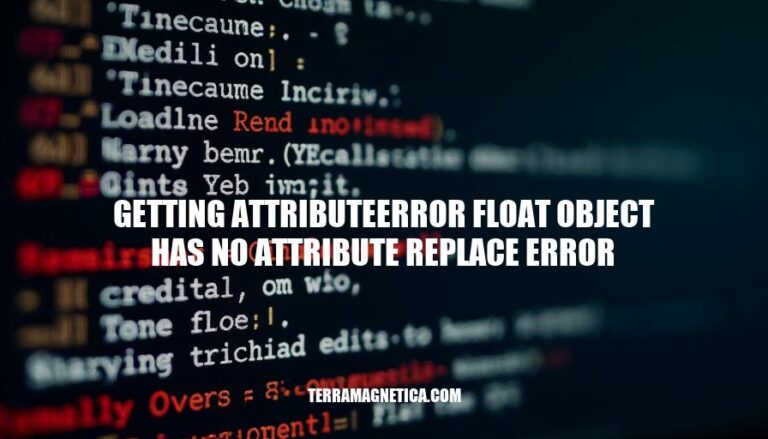


The AttributeError: 'float' object has no attribute 'replace' error in Python occurs when you try to use the replace() method on a float. This method is specific to strings, so attempting to call it on a float will result in this error. To fix it, you need to convert the float to a string first, like this: str(your_float).replace(). This error typically happens when there’s an unexpected float value where a string was intended.
Here are some common scenarios that lead to the AttributeError: 'float' object has no attribute 'replace' error:
Direct Method Call on a Float:
value = 3.14
value.replace('.', ',') # Raises AttributeError
Attempting to use the replace method directly on a float object.
Function Argument Type Mismatch:
def process_value(value):
return value.replace('.', ',')
process_value(3.14) # Raises AttributeError
Passing a float to a function that expects a string and uses replace() internally.
Data Type Conversion Issues:
value = 3.14
if isinstance(value, str):
value.replace('.', ',') # Raises AttributeError if value is not converted to string
Incorrectly assuming a float is a string without proper conversion.
Mistyped Variable:
value = 3.14
value.replace('.', ',') # Raises AttributeError
Mistyping or misunderstanding the type of a variable, leading to incorrect method calls.
Data Parsing Errors:
data = [1.23, 4.56, 7.89]
for item in data:
item.replace('.', ',') # Raises AttributeError
Attempting to use the replace method on elements of a list that contains floats.
In all these cases, converting the float to a string before using the replace method can resolve the error:
value = 3.14
value_str = str(value)
value_str.replace('.', ',')
These scenarios highlight the importance of understanding data types and ensuring the correct type is used for method calls.
To identify and fix the AttributeError: 'float' object has no attribute 'replace' error in your code, follow these steps:
Understand the Error: This error occurs when you try to use the replace method on a float, which is not valid since replace is a string method.
Check Variable Types: Ensure the variable you are calling replace on is a string. You can use print(type(variable)) to check the type of the variable.
Convert Float to String: If the variable is a float, convert it to a string before using replace:
my_float = 3.14
my_string = str(my_float).replace('.', ',')
Debugging Tips:
isinstance(variable, type) to ensure the variable is of the expected type before calling methods on it.Example:
data = [1.23, 4.56, '7.89']
for item in data:
if isinstance(item, float):
item = str(item)
item = item.replace('.', ',')
print(item)
By following these steps, you can effectively identify and resolve the AttributeError in your code.
Sure, here are the steps to resolve the AttributeError: 'float' object has no attribute 'replace' error:
Identify the variable causing the error:
value = 3.14 # Example float value
Convert the float to a string:
value_str = str(value)
Use the replace method on the string:
value_str = value_str.replace('.', ',')
If needed, convert the string back to a float:
value = float(value_str.replace(',', '.'))
Here’s the complete code:
value = 3.14 # Example float value
value_str = str(value) # Convert float to string
value_str = value_str.replace('.', ',') # Use replace method
value = float(value_str.replace(',', '.')) # Convert back to float if needed
This should resolve the error by ensuring the replace method is used on a string, not a float.
Check Data Types: Ensure variables are strings before calling string methods like replace(). Use isinstance(variable, str).
Convert Floats to Strings: Use str(variable) before applying string methods.
Handle NaN Values: Use libraries like pandas to manage NaN values in dataframes.
Use Try-Except Blocks: Catch and handle exceptions gracefully to prevent crashes.
Validate Input Data: Ensure input data is in the expected format before processing.
To resolve this issue, it’s essential to understand and handle data types correctly in Python.
When working with floats, converting them to strings is often necessary before applying string methods. This can be done using `str(float_variable)`. However, keep in mind that this conversion may lead to precision issues if dealing with very large or small numbers.
To prevent crashes due to attribute errors, use try-except blocks to catch and handle exceptions gracefully. This allows your code to continue running even when encountering unexpected data types or formats.
By understanding and handling data types correctly, you can avoid attribute errors and write more robust Python code that handles various scenarios effectively.